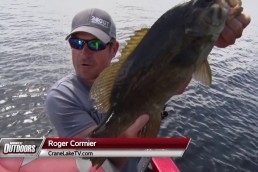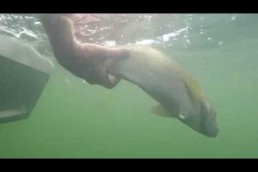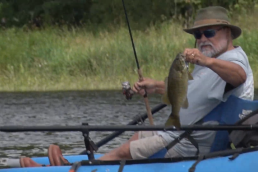Lake Michigan’s Summer Smallmouth Bonanza
SHARE THIS POST
Whenever someone mentions Lake Michigan, chances are good that images of trophy-sized salmon and trout will come to mind. Chinook salmon, coho salmon, steelhead trout and brown trout are popular species for local anglers, and fishing for them is very good. Don’t forget about the deep-water lake trout, either. They have a devoted following among Hoosier fishermen, too.
Once the warm weather of summer sets in, however, these fish move offshore and are often out of the reach of shore fishermen and inshore-loving anglers with small boats. Luckily, that’s not a problem these days. Lake Michigan is home to a great population of smallmouth bass, and the fishing for them has never been better.
In fact, the near-shore smallmouth bass fishing on Lake Michigan is actually fantastic! Bass anglers have the opportunity to catch fish in the 3- to 4-pound class nearly every time they hit the water, with a real chance at a trophy in the 5-pound range! Where else can you go in Indiana with odds like that?
One reason the smallmouth bass fishing is so good is because of excellent habitat along the southern shores of Lake Michigan. A combination of shallow water, rocky breakwalls and boulder-strewn shorelines has resulted in the perfect breeding ground and living space for a huge population of smallmouths.
Another reason for the success of the smallmouth is an extremely plentiful food supply. Crayfish have long been a favorite food of smallmouth bass, and these miniature crustaceans love to live amongst the rocks and broken stones of the area’s breakwalls. Small minnows are also eaten in great quantities by the voracious bass, and during the spring spawning runs of gizzard shad and alewives, the bass can really put on the feedbag.
An abundance of available forage certainly helps to grow more and larger smallmouth bass, and the bass have learned to take advantage of another good food source, too. Exotic species like the round goby now call Lake Michigan home, and although fishermen hate the gobies, the smallmouths love them. Gobies are a small bottom-dwelling fish that entered the Great Lakes many years ago via ballast water from ocean-going freight ships, and they prefer to live along shallow, rocky shorelines—just like smallmouth bass!
Excellent bass fishing can be experienced on the big lake from spring through fall, although the summer months are often the best. That means now is the time to get ready for some hot smallmouth action, so get your gear ready and hit the water!
Are you enjoying this post?
You can be among the first to get the latest info on where to go, what to use and how to use it!
Hoosier smallmouth hotspots
In spring, smallmouth bass start moving back into the shallows to search for food and to find suitable spawning habitat. Luckily, good habitat abounds along Lake Michigan’s shoreline, especially along the western edge of the Indiana coastline in Lake County. The rocky shores of Whiting, Hammond, East Chicago and Gary are literally teeming with smallmouth bass. By summertime, bass seem to be everywhere.
These locations were not chosen by bass at random or by accident. There is a large amount of rocky structure in these areas that attracts smallmouth bass like a magnet. Stone and concrete breakwalls were created here by local municipalities and industrial companies along the lakefront to protect against shoreline erosion. Boulders, cut stone, gravel and chunks of concrete were added to break up the waves. These irregular rock walls provide perfect hiding places for crayfish and small minnows, both of which are favorite prey of the resident bass.
Rocky breakwalls were also erected to protect harbors and marinas from storm-driven wind and waves. During construction of the breakwalls, pieces of stone (large and small) often tumbled out onto the lake bottom and settled along the base of the walls, creating more habitat for the bass. Boaters moor their craft behind the safety of these walls throughout the boating season, but they also fish along the rocky walls for a chance to catch a trophy-sized smallmouth bass.
The shorelines along Whiting, Hammond and East Chicago are especially well-suited for Great Lakes smallmouths. These areas include a mixture of public parks and industrial property, and the areas along the water’s edge are completely covered with jumbled boulders and cracked stone. Whiting Park, the Hammond Marina and East Chicago’s Pastrick Marina are just some of the more popular places to fish for smallmouth, both from shore and from a boat.
For boaters, East Chicago, in particular, has an abundance of smallmouth bass habitat within an easy boat-ride from Pastrick Marina. Two hot areas are Buffington Harbor to the east and Inland Steel (owned by Arcelor-Mittal) to the west. Both have long breakwalls made up of huge rocks and irregular boulders that are frequented by large numbers of smallmouth bass of all sizes.
The Hammond Marina is also an excellent place to begin a search for big-lake smallies. This marina is protected by a large rock breakwall, but it also features a second submerged wall of large stones several yards in front of the main breakwall. This submerged wall rises to within a few feet of the surface, and it helps to break and dampen larger waves before they hit the main breakwall. For fishermen, it is another bass magnet. Crayfish, small shad and hordes of gobies live in and around the rocky crevices of these walls.
There are fewer options for bass fishermen east of Gary, but there are still some excellent spots to try. There is also good fishing in front of the Port of Indiana. The water is deeper there and it’s not fished as heavily as Hammond or East Chicago. As a matter of fact, the outer wall of the port is protected by a secondary underwater wall similar to the one in Hammond. Called “The Reef” by locals, this submerged wall holds plenty of hefty bass.
Although most Lake Michigan smallmouth fishermen release the bass they catch to fight another day, it is legal to keep a fish or two for the table. If you decide to keep a fish, be sure that you are aware of the special regulations in effect for all black bass (largemouth or smallmouth) on Lake Michigan. The daily bag limit is three fish and the minimum length is 14 inches. Better yet, release them all and you won’t have to clean fish when you get home!
MWO
SHARE THIS POST
Did you enjoy this post?
You can be among the first to get the latest info on where to go, what to use and how to use it!
Tom Berg
A lifelong outdoorsman and award-winning outdoor writer and nature photographer, Tom Berg has been the Executive Director/Treasurer of the Hoosier Outdoor Writers group for the past 14 years. When he is not writing, he would rather be outside fishing, hunting or trapping than doing just about anything else.



